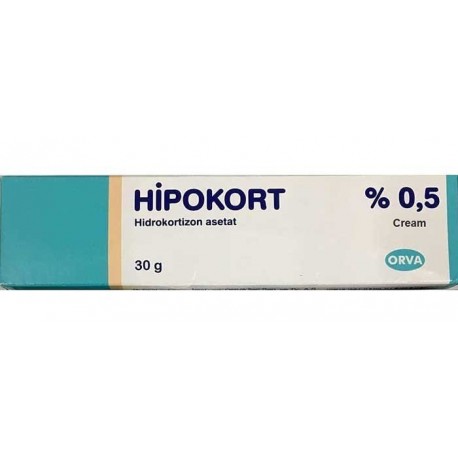 View larger
View larger Hipokort (Hydrocortisone) Cream&Ointment 30 G
New product
BUY MORE PAY LESS
| Quantity | Discount | |
|---|---|---|
| 2 | 5% | |
| 3 | 10% | |
| 4 | 15% | |
| 5 | 20% |
Volume discounts
| Quantity | Discount | You Save |
|---|---|---|
| 2 | 5% | Up to $3.20 |
| 3 | 10% | Up to $9.60 |
| 4 | 15% | Up to $19.20 |
| 5 | 20% | Up to $32.00 |
More info
HIPOKORT (hydroquinone) 0.5% cream is applied on the skin.
Active ingredient
: Each 1 g cream contains 5 mg Hydrocortisone acetate.
Excipients
Olive oil, Cyclomethicone, Cetostearyl alcohol, Liquid paraffin, White soft petrolatum, Polysorbate 20, Isopropylmyristate, Glycerinmonostearate, Polysorbate 80, Butyl hydroxyanisole (E320), Triclosan, Chlorhexidine hydrochloride, Disodium EDTA, Purified water.
1. What HIPOKORT (hydroquinone) is and what it is used for
HIPOKORT (hydroquinone) is a cream for external use. It belongs to a group of drugs called weak-acting corticosteroids (group I). As an active ingredient, it contains 0.5 g of Hydrocortisone acetate per 100 g.
HIPOKORT (hydroquinone) is offered for use in an aluminum tube containing 30 g of white colored cream, closed with a plastic cap.
HIPOCORT (Hydrocortisone); contact dermatitis (a skin disease that occurs as a result of contact with irritants such as cleaning materials such as water-soap, cosmetics, jewelry, etc.), occupational eczema (a skin disease that develops as a result of frequent encounters with irritant and allergic substances in daily activities related to the occupation), nummular- degenerative eczema (an allergic skin disease with coin-shaped tissue damage in the legs and buttocks seen in winter months) and seborrheic eczema (redness, oily-yellow dandruff crusting on the scalp, nose and lip grooves, armpits, under the breasts or groins) an inflammatory skin disease manifested by scaling and scaling), dyshidrotic eczema (a disease characterized by the formation of itchy blisters on the skin of the hands and feet), eczema in varicose syndrome (a skin disease especially in the areas of enlarged veins in the legs), pediatric eczema, neurodermitis (psychological problems) a type of itching caused by anal eczema (rectal eczema), atopic dermatitis (chronic eczema with watery reddish-colored lesions that develop as a result of congenital or acquired hypersensitivity to some allergens), lichen ruber planus (especially manifested by small violet-colored bumps on the skin of the arms and legs, sometimes itching) It is used in the treatment of allergic and inflammatory skin diseases that respond to local treatment such as psoriasis (psoriasis), insect bites, 1st degree burns, and sunburns.
2. How to use HIPOKORT (Hydrocortisone)?
Instructions for proper use and dose/frequency of administration
It is usually applied as a thin layer 1-2 times a day at the beginning of the treatment.
Application route and method
It is applied by rubbing on the skin.
Pierce the tube by inverting the cap.
different age groups
Use in children
It should be used in infants and children under 6 years of age under the supervision of a physician and the duration of use should not exceed 5-7 days.
Use in the elderly
Applications on large surfaces should be avoided.
Use in the elderly
Use in the elderly
Special use cases
Kidney failure:
No dosage adjustment is required in patients with renal impairment. Hepatic impairment:
In patients with liver failure; Use HIPOKORT (Hydrocortisone) under careful observation, especially in cases where occlusive dressing that facilitates absorption from the skin is required, due to the increased passage of Hydrocortisone acetate into the bloodstream. Effects may occur due to the passage of the drug into the bloodstream. If you have the impression that the effect of HIPOKORT (Hydrocortisone) is too strong or too weak, talk to your doctor or pharmacist.
If you use more HIPOKORT than you should
HİPOKORT can be absorbed through the skin at a rate that may cause systemic side effects as a result of overdose.
If you have used more than you should use from HIPOKORT (Hydrocortisone), talk to a doctor or pharmacist.
If you forget to use HIPOKORT (Hydrocortisone)
Do not apply a double dose to make up for forgotten doses.
Effects that may occur when treatment with HIPOKORT (Hydrocortisone) is terminated
Depending on the discontinuation of treatment, symptoms may recur (rebound effect).
3. What are the possible side effects?
Like all medicines, there may be side effects in people who are sensitive to the substances in the content of HIPOKORT.
If any of the following occur, stop taking HIPOKORT (Hydrocortisone)and IMMEDIATELY inform your doctor or go to the nearest hospital emergency department:
• Serious allergic reactions (difficulty in breathing, severe dizziness, itching/swelling especially of face, tongue and throat, rash)
These are all very serious side effects.
If you have one of these, it means you have a serious allergy to HIPOKORT (Hydrocortisone). You may need emergency medical attention or hospitalization.
All of these very serious side effects are very rare.
Tell your doctor if you notice any of the following:
• Weight loss in children, slowed growth
• Exacerbation of your skin disease or occurrence of another infection
• Burning, stinging, dryness, irritation on the skin
• Folliculitis (follicle inflammation)
• Hypertrichosis (hairy)
• Hypopigmentation (the formation of white patches on the skin)

